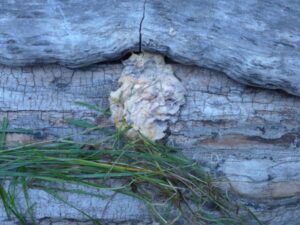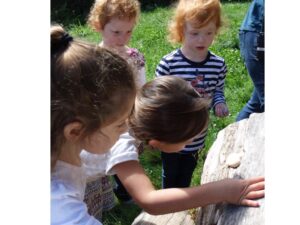Fear can’t survive proximity

What happens when fear drives our actions – and how can we interrupt it?
This is a story about four-year old Mason. He is a passionate person, full of ideas, questions, and working theories of the world that he readily shares with his community. He has a generous heart with everyone and his perspectives of the world provoke all of us to consider the tensions that live inside of an idea or question.
One day, he offered his community a chance to uncover assumptions about good and bad, the known and unknown. The children were playing in Outdoor Adventure when they found an unusual looking fungus growing on a log. Many of them were curious to look at it, but no one ventured to try and touch it or get too close to it. Then Olive noticed something upsetting: “Mason is trying to hurt part of Mother Nature!” By contrast, Mason was looking intently at the fungus and poking it with a stick. He yelled, “It is scary and it has to be destroyed.” In this moment, as the children shared their thinking, it was clear that the fungus, a part of Mother Nature, was being interpreted simultaneously as good and bad.

Olive tried to intervene by saying calmly yet firmly, “If it’s scary to you, you can just walk away Mason. You can walk away; you can walk away.” After such a strong stance, we were surprised when Mason slowed down then stopped what he was doing and said, “I’m going to walk away.”
Mason had tossed the community a ball – a problem (or tension) full of complexity that was also deeply connected to our research questions of transformation and the relationship between feeling scared, practicing empathy, and taking risks. His words resonated the ideas we were seeing around the world: It is scary and it has to be destroyed.
Over time, Caroline and I noticed a few moments when the children wanted to destroy things they found scary – a bug, a spider, or a fungus growing on a log. Fear of the unknown would hijack their ability to be curious and compassionate, interrupting their ability to consider another perspective or problem-solve in a productive way. We wondered, how might we support the children to slow down and ask a question when, as humans, we’re hard-wired for fight or flight? How could we practice the habits of mind needed when we encounter something (or someone) that threatens our safety?
We noticed a strong connection between some of the children’s responses to fear and some adult responses to fear — often with violence — towards people who are different from them, either in the way that they look, or act, or how they live their lives, or express their beliefs.
We wanted to dig into these questions:
How might we learn to value and celebrate differences?
How would developing an understanding of how to co-exist with others who have diverse ways of being support our own existence?
How could we cultivate curiosity within ourselves when we’re filled with fear?
As teachers, the choices we make to address these questions, or not, is inherently political.

We can choose to cling to our fear and let it control our actions, misleading us into a world of certainties where things are black or white, right or wrong, good or evil. And this may lead us to respond by ignoring the thing that makes us fearful, moving away from it, separating ourselves from it, shifting from feeling fearful to an attitude of complacency that allows us to move through the world without acknowledging or engaging with the things that make us afraid, as it appears Mason did when he decided to walk away with Olive’s encouragement.
At Opal School, we talk about this leaning into our fears in a range of ways: “making friends with uncertainty”; “embracing uncertainty”; “getting comfortable with our discomfort”; “moving into the ‘safe to risk’ zone between our comfort and danger zones.” What happens when we respond by uncovering the source of our fear, within us, to try to understand or even eradicate it, rather than the thing or person who is pushing on our fear? What happens when we lean into what makes us feel afraid, with an open heart and mind, to try to make sense of it, so we can make sense of how we want to be in the world?

Thank you for you careful and compassionate consideration as you watched this small moment between children. You might have not stopped to listen. Instead it evolved into deep understanding. We too have been asking similar questions, because it is necessary in these pervasively unjust times. Beautiful.
Glad to know these posts are finding you in DC, Marla: It feels more important than ever that we build community within our classrooms and schools as well as between our classrooms and schools.